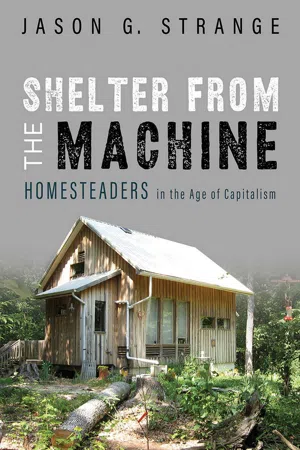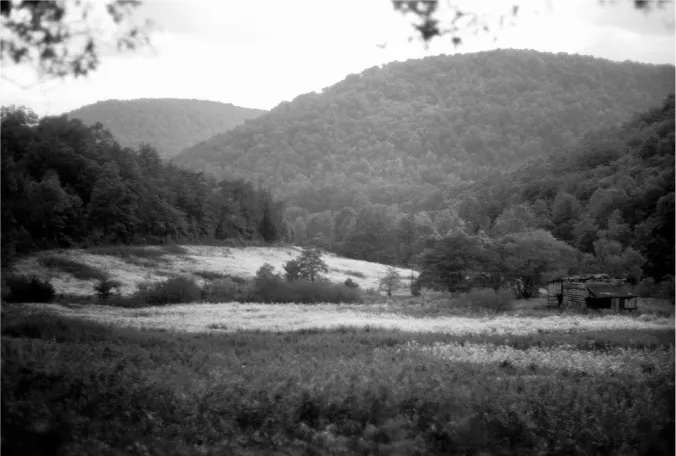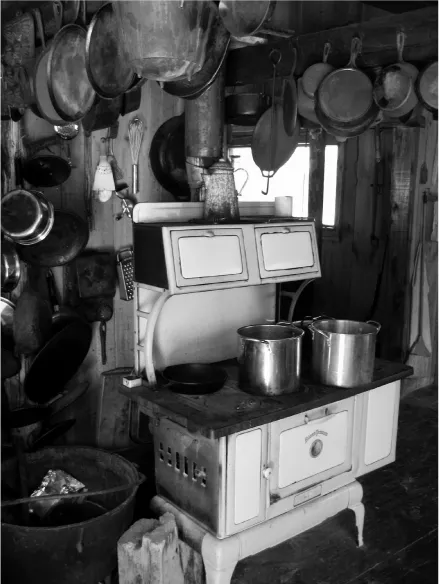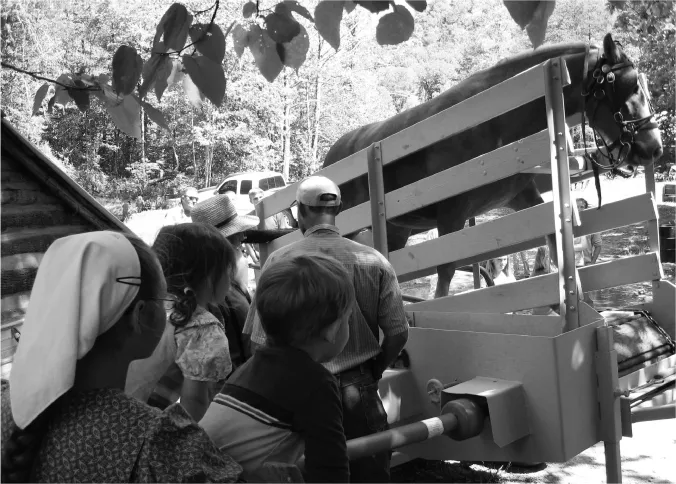![]()
PART I
The Story of Homesteading over Time
![]()
1 You Can See Other People’s Poop
It’s a sunny Saturday afternoon in early June, and I’m heading to an all-night pig roast at Nathan Hamilton’s homestead. I start from Berea, the little college town where I live and work, driving east on the winding two-lane road that runs through Bear Lick Valley. The valley is twenty miles long and cuts through three different counties; its bottom, carved by Bear Lick Creek, is a rolling grassland of cornfields and cow pastures, overcome a bit more each year by a rectilinear tide of crewcut lawns and vinyl-clad ranch houses. On both sides of the valley, steep wooded slopes rise five hundred feet into ridges and knobs, the trees dark and lush. A white limestone cliff-line rings the ridgetops and peeks through the forest like a grin. When fogs cloak the valley floor in the morning, the mountains look unreal, like a watercolor painting of themselves. Like someplace far away and long ago.
I drive past clusters of pickup trucks at the country store. Past the gravel lot where a dozen families spread worn merchandise in an impromptu open-air flea market. Past mobile homes with their homemade front porches and barking dogs. Chicory and tiger lilies crowd the roadside like children at a parade. After twenty minutes, I take a left onto a single-lane road that leads to a holler known as Redbud Branch. It’s a four-wheel-drive route in the best of weather, so I park my Honda Civic on the edge of the gravel, up against thick bouquets of poison ivy. A hundred feet ahead, the narrow road drops over the bank and into Redbud Creek—road and stream become one. I slip off my shoes and hike upstream through the cold current, the shallow water flowing over ledges of flat black slate. Golden nodules of crystalline pyrite poke up like fried eggs from the ebony stream bottom. In the deeper pools, crawdads backpedal from my splashing feet.
A Bear Lick side holler
After walking up the creek for a mile through a quiet tunnel of forest, I emerge into open space: a meadow nestled deep between the mountains, with fresh-cut hay stacked ten feet high on poles set alongside the dusty road. The way branches along with the creek, heading off into different side hollers, where a half-dozen homesteads are scattered and hidden throughout the woods.
Following the main creek for another half mile, I arrive just as the first breeze of evening cools my brow. Nathan’s place is an extraordinary example of a contemporary homestead, even for rural Appalachia. A large cabin sits on a hillside among the trees, with board-and-batten siding, a tin roof, and a wrap-around porch. The foundation is dry-stacked stone from the creek. On the slope behind the house stands a little ivy-covered outhouse with a crescent moon cut into the rough-sawn door. We are far from the grid: the cabin has no electricity, no television, no phone, no municipal water. It’s not a “push-button home,” as Nathan would say. He lives alone at present—he has a grown son from an early relationship—and cooks on a wood-fired stove, lights with kerosene lamps, and pumps well water with a foot pedal under the sink. Built from lumber that he and his uncles and brothers logged and milled with a portable band saw, the house looks like a photo from a hundred years ago—except for the bright red and yellow cylinder of an Igloo water cooler set on the edge of the porch, which turns out to be full of cold sassafras tea. On the flat ground by the creek, a half-acre garden, plowed and disked in the slightly wandering lines drawn by a team of horses, is green with spinach and beans and potatoes and squash. Beside the garden is a pond full of fat catfish, and a barn where Nathan keeps a milk cow, some goats and chickens, and a sibling pair of workhorses.
Nathan was born in a cabin much like this, without electricity or running water, on top of a nearby mountain. “I was born up there at Grandpa and Grandma’s house,” he told me once, when I asked about his early life. “We stayed there until I got healthy enough, strong enough to travel, and then went home. They packed me home on a horse, right on a saddle, and it was the awfullest blizzard I reckon that’s ever been in this country, I mean zero and below zero temperatures, and a huge snow.” Nathan grew up working the garden, feeding the animals, helping his father craft rocking chairs for sale, and gathering ginseng, goldenseal, and mayapple. But mostly, he said, he ran wild in the woods. By his tenth year, he spent days alone in the forest, coon hunting with his hound dogs and his pony. He never set foot in a schoolhouse. He has never been to a doctor. He has no social security card, driver’s license, or formal institutional existence whatsoever.
A non-push-button kitchen
This sounds like a story from long ago. But Nathan was born in the blizzard of 1978. As I write, he is thirty-nine years old, strong and energetic but no longer lean, a handsome man with dark hair and a big dark beard and a ready laugh. He has a thick country accent that, unlike the television stereotype, strikes a mainstream American ear—like many British accents—as dignified. He is one of the sharpest people I have ever known, and often unleashes better sentences on the fly, verbally, than I can build painstakingly on paper. His diction is his own, full of words like “dramastically,” a melding of dramatic and drastic, which you won’t hear anywhere else.
I hiked into the holler both to be with friends and in search of answers to a question: why do people live like this? Why do people still turn to the land? Looked at a certain way, it seems a dumb question. Listen to the music of the creek! Breathe the scent of wildflowers! Why would anyone not live like this? But in many ways, it’s a hard life, and not one most of us show any serious interest in pursuing. In the winter, families in Redbud Branch often can’t get in or out, sometimes for weeks. Nathan’s postcard-ready garden and cabin and barn are the fruit of hard labor. There’s no Netflix. No microwave. No pad thai delivered to your apartment door. Many things that make life in a town or city seem worthwhile are absent here.
* * *
When I get to Nathan’s cabin, it’s quiet, though people have started to arrive. On the grass verge between road and creek, a few four-wheelers are parked beside a wooden horse-drawn buggy that sports modern rubber tires. Several generations of the family have gathered to prepare for tomorrow, and the pig has already been split and laid on the grill, covered tightly with a lid shaped from roofing metal. Nathan and a half-dozen uncles and brothers sit on chunks of firewood in a circle around a nearby campfire. They’re wearing leather work boots, jeans, long-sleeve flannel shirts, and suspenders. Most grow their beards long and shade themselves with Amish straw hats. Talking and tending the meat, they’ll stay up through the night. There’s no drinking and very little swearing. Nathan used to drink, but it “cut me down hard,” he said, and he swore it off.
Old-fashioned torque
Tomorrow, on foot and horseback and piled four and five on ATVs, two hundred people will roll into the holler. A line of hay wagons beside the garden will brim with potluck dishes—pies and casseroles and potato salads and more pies. A mare will lumber placidly up the endless hill of a treadmill; horse-powered treadmills were a nineteenth-century source of torque. In this case, that torque will be used to churn ice cream. Two stallions will get in a fight, an incredible mass of animal, rearing and snapping at each other’s necks, dogs snarling at their hocks. Waving hats and bellowing, the men will charge in, but the fight ends only when one stallion tumbles over the bank and flees clattering down the creek bed.
For now, the sun is setting and everything is calm. The men pass stories back and forth across the fire. They talk farming: spray bleach or vinegar on a field, it’ll kill the weeds. They talk trades; they love to trade. Nathan no sooner gets one truck than he’s ready to swap for another. They appraise a gooseneck trailer parked by the creek, put prices on it. “I’d like that one,” says Nathan’s brother Abe, “it’s got no wood to rot out.” They talk about breaking horses and mules. A local man, Everett Combs, was renowned for how well-trained his mules were. “Once,” another brother says—pronouncing it wunst—“I was driving down Big Hill, and there come the mules and the wagon, and no driver. Then, presently, around the corner, comes Everett on the tractor.” That gets a laugh. Uncle James recalls the time Everett overdrank and passed out in his wagon—and the steady mules guided him home over miles of country roads.
Since we’re talking about animals, Nathan has a concern to air. He pulls his beard and ventures, “Fellers, I think my dogs are bitin’ my cow.”
His uncle Hiram has an easy answer for that: “Castrate ’em.” He volunteers to tackle the job. “I’ll castrate just about any kind of critter,” he says, “if it’s aggravatin’ me.” He bought a boar once, but the “maleness stinks up the meat.” Boar taint, they call it. “Not even a billy goat is like that!” So they tied his forelegs to the front end of the truck and pulled him out and his “balls just hung right there off the tailgate.” Easy clipping. Then they fattened him up on corn, and the meat, he says, was tender and delicious.
In the dusky light, a four-wheeler growls along the dirt road and into the yard. One of Nathan’s teenage nephews is driving, an elderly woman perched on the seat behind him. Ruth Hamilton, Nathan’s grandmother and the family matriarch, has spent the afternoon at her cabin, a couple of hollers over, baking vinegar pies for the gathering. Clad in a long brown dress and bonnet, thin face alert like a raptor, Ruth walks up to the fire to greet her children. The talk was already trending spiritual before Ruth showed up—but life, for her, is nothing more nor less than a celebration of the Lord. She is a holy woman, ecstatic and forceful in her faith.
I am a little concerned: raised by two southern whites recoiling from conservative Christianity, I experienced exactly zero church services in the first twenty years of my life; the handful since, I have attended in a sociological mode. What if Ruth asks if I’ve embraced the Lord our Savior? Or suggests that I lead a prayer? I can’t imagine not being honest about my lack of religious belief—but how would they respond?
Ruth takes a seat by the fire and salts the conversation with well-timed interjections of “Praise the Lord!” Her hallelujahs soon have them in an overtly religious mood, which puts Hiram in mind to tell a story. “You know, I can’t read much,” he begins; like Nathan, Hiram has never been in a schoolhouse. “But that Bible, sometimes, it’s just as clear as water.” He was reading in Revelation a few weeks back, he says, serious now, “reading about the Beast.” No more laughing; this isn’t a story about pinching the balls off some punk tomcat. He walks us through the scripture. The Beast came out of the ocean. From the bottomless pits. In its nostrils were fire and black smoke. It’s deadly, full of power, and even kings kneel helpless before it.
“I kept wondering, kept asking myself, what is the Beast?” He pauses, rearranging the embers with a stick. Gives us time to feel his question. “Then, finally, it came to me,” he says. “The beast is crude oil.” What else rises from the ocean depths with smoke and flame? What else has such power to control and destroy? What else holds the people so tightly in its grip? We all drive, Hiram points out. We all buy gas. “We all,” he concludes, “carry the mark of the Beast.”
Once that knowledge came to him, he parked his truck, hitched the horses to his buggy, and hasn’t driven since.
The sun sets, and night folds ’round. Ruth calls for a prayer. Everyone stands up from their seat around the fire and faces out into the dark forest. I expect Ruth to lead, but each pray to themselves. Even as an atheist, I can feel that sense of supplication before larger forces. Of voices raised within the mystery. I feel our ephemerality; we are here and then gone, like a raindrop born in cloud and sundered on the earth. Beside me, I hear Nathan singing a quiet hymn. “Without Jesus’ blood washing me of my sins,” he whispers, “I’d be gone tomorrow.”
* * *
My arms are covered to the elbow in mud and prickly bits of straw. The mud tugs pleasantly on my skin as it dries. It’s late June now, and sweltering; Bear Lick Valley is living up to its official designation as part of the humid subtropics. Beside me, Virginia Webb grabs a double fistful of wet straw and clay from a wheelbarrow and crams it into a gap in the wall in front of us. The wall is made of straw bales, stacked in staggered rows like giant bricks. We’re rushing to fill all the joints, so that when the first coat of earthen plaster is applied to this section of wall—hopefully later this afternoon—it won’t disappear uselessly into crevices and fissures.
Virginia is in her mid-forties, with a firm, full body strengthened by labor. Her black hair is pulled out of the way in a French braid. She works as a potter, renting a little craft shop in Berea with several other artisans. About thirty people have gathered on this Saturday for a work party to help finish her straw-bale house, which she began three years ago with her partner Lisa, an elementary-school teacher from Philadelphia. They painstakingly built a timber frame and a roof, and then Lisa—burned out from working in the evenings, tired of being a lesbian in rural Kentucky, missing the lights of the city—bailed back to Philly. Virginia and her teenage daughter, Rachel, lived for a year inside the unfinished structure, out of the rain but in the open air, sleeping in a tent to keep out the mosquitos in July, and the frost in December. Taking a pause from building, resting, recalibrating their lives. “I wasn’t sure what to do,” Virginia told me with a sigh, “after Rachel started college. It’s a much bigger project, when you’re alone. I really thought about moving to town.”
She decided to push on, and the house looks nearly finished now. The bales are stacked and the windows and doors are framed—but the exterior walls are only halfway plastered. Like many straw-bale houses, it’s both home and artwork. From a distance, it looks like a cuter, smaller version of a normal house: a rectangle with a gabled roof of tin, perched on the side of a hill overlooking Virginia’s garden and, a couple hundred feet below, the green floor of Bear Lick Valley. But when you get closer, you notice subtle curves and undulations in the walls. A bas relief phoenix flies up one side of the house, sculpted from clay, and at the top of one wall, wine bottles are laid within a cob mortar, to let multihued light filter inside.
Straw bales make beautiful, functional homes. When the foundation is done correctly, they’re as rot-resistant as a framed house. They stack quickly, like giant Legos—walls often go up in a day—and they are superbly insulated. But, without much help from machines, the plastering is fiendishly labor intensive. Virginia has dug the clay for the plaster on site, and painstakingly worked it through a screen to remove stones. There’s a great turnout for the work party today, but we will only get through part of the plastering that remains to be done.
In addition to being a homebuilder, Virginia is such a skilled gardener that when I buy groceries at Berea’s Wal-Mart, I feel her sitting, as it were, upon my shoulder, shaking her head in disgust as I pay for things I ought to have grown. But it makes for a busy life. Today has been typical: in the middle of preparing to host a work party, she says with an edge of exasperation, a package arrived in the morning mail, one that had to be dealt with quickly. Virginia is also a beekeeper, and the package contained a live queen, sequestered in a tiny box with a small retinue of helper bees. I’ve watched her check the hives before. Wearing the usual netted cowl over her head, but with her hands bare, she handled the honeycomb with a watchmaker’s precise touch, leaving the bees calm. Striped yellow and brown, they crawled over her fingers like rings hammered from living gold.
“Last week,” she tells me, gathering another clump of straw-clay mix, “I decided that one of the hives needed re-queening.”
“I’m not sure what that means,” I reply.
“The old queen wasn’t p...



